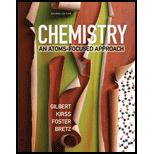
To find:
The color of red cabbage juice at equivalence point when
Answer to Problem 16.54QA
Solution:
Red cabbage juice would have yellow color since pH of the solution at equivalence point is in the alkaline region.
Explanation of Solution
1) Concept:
We are asked to find the color of red cabbage juice at equivalence point when a weak acid, acetic acid and a strong base, sodium hydroxide are titrated. Since red cabbage juice is a sensitive acid-base indicator, we need to find pH of the solution at equivalence point. Red cabbage juice changes its color as the pH of the solution changes. It shows red color at acidic
The equivalence point of a titration is the point at which chemically equivalent quantities of base and acids have been mixed. So, to reach equivalence point
At equivalence point, neither acetic acid nor
We can calculate
2) Formula:
i)
ii)
iii)
3) Given:
i) Volume of acetic acid is
ii) Molarity of acetic acid is
iii) Molarity of
4) Calculations:
The initial quantity of
At equivalence point,
The quantity of
We can use a modified RICE table to determine how many moles of
| Reaction | |||
| Initial | |||
| Change | |||
| Final |
The total sample volume is
The concentration of acetic acid and acetate ion is
Because the product of the neutralization reaction is a weak base, we must consider the reaction of the weak base with water to calculate
The equilibrium reaction of acetate with water is as follows:
The equilibrium constant for this reaction is
| Reaction | |||
| Initial | 0 | ||
| Change | |||
| Equilibrium |
On solving this equation we get
Since
Conclusion:
As expected for the titration of a weak acid and a strong base, the
Want to see more full solutions like this?
Chapter 16 Solutions
CHEMISTRY:ATOMS-FOCUSED..-ACCESS
 ChemistryChemistryISBN:9781305957404Author:Steven S. Zumdahl, Susan A. Zumdahl, Donald J. DeCostePublisher:Cengage Learning
ChemistryChemistryISBN:9781305957404Author:Steven S. Zumdahl, Susan A. Zumdahl, Donald J. DeCostePublisher:Cengage Learning ChemistryChemistryISBN:9781259911156Author:Raymond Chang Dr., Jason Overby ProfessorPublisher:McGraw-Hill Education
ChemistryChemistryISBN:9781259911156Author:Raymond Chang Dr., Jason Overby ProfessorPublisher:McGraw-Hill Education Principles of Instrumental AnalysisChemistryISBN:9781305577213Author:Douglas A. Skoog, F. James Holler, Stanley R. CrouchPublisher:Cengage Learning
Principles of Instrumental AnalysisChemistryISBN:9781305577213Author:Douglas A. Skoog, F. James Holler, Stanley R. CrouchPublisher:Cengage Learning Organic ChemistryChemistryISBN:9780078021558Author:Janice Gorzynski Smith Dr.Publisher:McGraw-Hill Education
Organic ChemistryChemistryISBN:9780078021558Author:Janice Gorzynski Smith Dr.Publisher:McGraw-Hill Education Chemistry: Principles and ReactionsChemistryISBN:9781305079373Author:William L. Masterton, Cecile N. HurleyPublisher:Cengage Learning
Chemistry: Principles and ReactionsChemistryISBN:9781305079373Author:William L. Masterton, Cecile N. HurleyPublisher:Cengage Learning Elementary Principles of Chemical Processes, Bind...ChemistryISBN:9781118431221Author:Richard M. Felder, Ronald W. Rousseau, Lisa G. BullardPublisher:WILEY
Elementary Principles of Chemical Processes, Bind...ChemistryISBN:9781118431221Author:Richard M. Felder, Ronald W. Rousseau, Lisa G. BullardPublisher:WILEY





